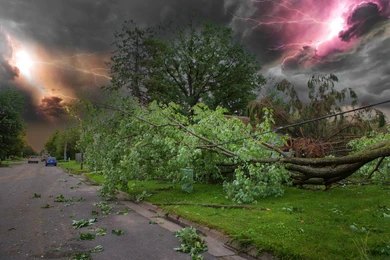Storms can bring severe and sometimes unexpected damage to our property. For young professionals juggling hectic schedules, it’s essential to know how to prepare for these events effectively. Here are some steps to safeguard your trees and property before a storm, how to assess damage afterward, and where to find emergency tree removal services.

1. Evaluate Your Property’s Vulnerability
Taking an afternoon to walk around your property and assess the health of your trees can be quite revealing. Look for signs of disease or structural weaknesses in trees. Branches that are particularly low or extending over structures, like your house or carport, may pose a risk. Addressing these vulnerabilities early can save you a ton of hassle later.
2. Prune Dead or Weak Branches
Pruning is more than an aesthetic choice; it’s a safety necessity. Removing dead or weak branches lessens the chance they’ll become projectiles during high winds. Trust me; you don’t want to discover a dead branch through your windshield after the storm has passed.
3. Secure Outdoor Items
While this step might seem obvious, it’s often overlooked. Outdoor furniture, yard tools, and decorative items can become dangerous in a storm. Always secure these items in a shed or garage to avoid any potential damage to your property or others.
4. Create a Storm Emergency Kit
An emergency kit can be a real lifesaver, especially if you lose power or are unable to leave your home. Essentials like nonperishable food, bottled water, first aid supplies, a flashlight, batteries, and a batterypowered phone charger can make all the difference when riding out a storm.
5. Plan Your Evacuation Route
Sometimes, the best way to stay safe is to leave the area entirely. Have an evacuation route planned out well in advance, and share this plan with family or friends. Know where you’ll go and how you’ll get there. Make sure your car is fueled up and ready to go.
6. Assessing Tree Damage PostStorm
Once the storm has passed, the first thing to do is survey the damage. Check for broken or dangling branches, and examine the root system. If a tree appears unstable, keep your distance and call a professional immediately. It’s tempting to handle things yourself, but safety should always come first.
7. Document the Damage for Insurance Claims
Photographs can be vital when making insurance claims. Document the damage thoroughly, capturing images from multiple angles. This will not only make the claims process more straightforward but also provide an accurate record for any necessary repairs.
8. Hire a Certified Arborist
A certified arborist can assess the health and stability of your trees poststorm. These professionals can recommend whether a tree needs to be pruned, treated, or removed, and they generally know the most effective methods for preserving the health of your tree.
9. Emergency Tree Removal Services
Sometimes, tree damage is so severe that removal becomes urgent. Knowing which emergency tree removal services are reliable can save you from further stress. Many services operate 24/7 and can quickly help mitigate risks to your home or property.
10. Check Local Regulations
Before making any major changes to your property, including tree removal, check your local regulations. Certain trees may be protected, and there may be specific permits required for removal. Being informed ahead of time can prevent legal hassles later on.
11. Upgrade Tree Support Systems
For trees that might need additional support, consider installing cables or braces. These support systems can help maintain a tree’s structural integrity during high winds. Consult with an arborist to determine what’s suitable for your specific trees.
12. Invest in Lightning Protection for Trees
Yes, trees can be struck by lightning, and it’s often catastrophic. Lightning protection systems for valuable or historic trees can be a wise investment. These systems help direct the electrical charge away from the tree, reducing damage.
13. Ensure Drainage is Properly Managed
Flooding often accompanies storms, and poor drainage can exacerbate damage. Ensure that your property has proper drainage systems in place. Clearing gutters and checking drainage around the base of trees can prevent soil erosion and waterlogging, which weaken roots.
14. Replant with StormResistant Trees
If you live in a stormprone area and are considering planting new trees, opt for species known for their storm resistance. Trees like Live Oaks and Bald Cypresses can endure harsh weather better than some other varieties.
15. Regular Maintenance Pays Off
Regular maintenance isn’t just a prestorm activity; it should be ongoing. Scheduled pruning, health assessments, and professional consultations can ensure your trees remain resilient. A healthy tree is much more likely to withstand a storm than a neglected one.
By taking these steps, you can significantly reduce the risk of damage to your trees and property. Being proactive and making informed decisions are key to staying ahead of the storm.
